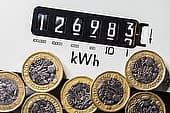Our excellent rating for green energy goes to GEUK. They offer 100% renewable electricity and 100% green gas by working with independent generators across the country.
Ecotricity and Good Energy are also excellent choices thanks to their commitments to green energy.
Octopus Energy, Scottish Power and E.ON Next are all examples of suppliers investing directly in renewable energy - and they are covered by the energy price cap.
At a glance
| Supplier | Green rating |
|---|---|
| GEUK | Excellent |
| Ecotricity | Excellent |
| Good Energy | Excellent |
| Octopus Energy | Good |
| Scottish Power | Good |
| E.ON Next | Good |
GEUK
Green rating: Excellent
GEUK, previously Green Energy UK, offers 100% renewable electricity and 100% green gas, making them the greenest energy provider in the UK right now.
They have three tariff options:
- Sparkling Tariff
- EKO Energy Tariff
- TIDE Tariff
Sparkling is the base tariff that uses fully green electricity and gas as standard.
Meanwhile, EKO adds more sustainability to a customer's energy footprint. It's an independently verified tariff that offers the following extras:
- Electricity and gas certified as 100% renewable
- Energy farms have to prove they are genuinely sustainable and mitigate the impact on their surrounding environments
- Energy is generated in locations that ensure marine and bird habitats are protected
- Funds renewable projects around the world
EKOEnergy is a sustainable step-up from Sparkling, bringing with it more emphasis on protecting the environment and tracking those efforts.
Finally, TIDE is a time-of-use tariff that utilises customers' smart meters to help them monitor and control their energy usage. It allows customers to:
- Access lower electricity rates between midnight and 7am
- Lower bills further by reducing electricity consumption between 4pm and 8pm on weekdays
- Use data from smart meter and appliance controls to modify behaviour
The electricity pricing for TIDE depends on the time of day and whether it's a weekday or a weekend, while gas prices remain static throughout the day.
This time-of-use tariff is great for charging an electric vehicle overnight, setting a washing cycle to start automatically or powering a slow cooker at off-peak times.
How green is it?
The energy provided by GEUK is the greenest and cleanest available.
Their electricity is drawn from solar, wind, hydro and biomass sources, while their green gas is generated from anaerobic digestion processes.
Although the company does not generate their own energy, they work with a network of independent commercial generators.
As we mentioned above, their EKO Energy tariff is independently certified as sustainable, suggesting GEUK's business model lives up to their promises.
Ecotricity
Green rating: Excellent
Customers signing up to Ecotricity will receive 100% renewable electricity and carbon offset gas (for now - there's more on this below).
There are three options for customers to choose from when they search for a tariff:
- Green Electricity + Green Gas
- Green Electricity
- Green Gas
As with most other suppliers, the price of these tariffs will vary depending where in the country a household is, so it's important to double check the standing charge and unit cost in an area using for an accurate quote.
There are also tariffs available for customers with EVs or Economy 7 meters.
How green is it?
Ecotricity style themselves as one of the greenest energy providers in the UK, and they back up their claims well.
They operate 24 wind parks across the country with enough windmills to generate power for over 56,000 homes. They also have a 1 MW sun park and are building new sun parks connected to windmills in Leicester and Devon.
It allows them to supply 20% of the renewable electricity they sell to customers, while the rest is purchased from other green generators or the wholesale market.
On the gas side of things, Ecotricity are in the process of building their own green gas mill in Berkshire but currently source 1% of their green gas from other green gas mills.
While admitting it isn't ideal, they also use carbon offsetting to neutralise the gas generated via fossil fuels that they sell on to customers. They say this is an interim solution until they can increase the amount of green gas generated and sourced.
One thing that makes Ecotricity different is their commitment to reinvest in new windmills, sun parks and green gas mills.
Profits are invested in new forms of renewable energy, meaning that Ecotricity don't just use what's available now - they're investing for the future.
Good Energy
Green rating: Excellent
Good Energy provide 100% renewable electricity sourced from UK generators and 10% green gas, while the rest of their gas supply is neutralised by carbon offsetting projects.
There are two main tariffs available from Good Energy:
- Standard Variable Tariff (SVT)
- Good to Fix
As the names suggest, the SVT is a variable tariff that can fluctuate while the other is a fixed tariff for up to 18 months.
At present, there are no electric vehicle or heat pump tariffs available from Good Energy - these are classed as closed tariffs as they can't currently be switched to, although they may reopen in future.
Good Energy's heat pump tariff was a UK first when it was unveiled in July 2020.
How green is it?
The 100% renewable electricity offered by Good Energy comes from over 1,900 independent generators across the country. They buy electricity directly from them and match it to every kWh used by their customers.
As well as this, Good Energy say their Power Purchase Agreements (PPAs) help renewable electricity projects to be built where they might otherwise not be.
They also own two wind farms and six solar farms across the UK, generating enough electricity to power 19,500 homes between them.
Good Energy also supply 10% biogas to customers on their gas tariffs. They say this figure is the maximum that can be sustainably produced in the UK.
The remainder of their gas supply is offset via a partnership with ClimateCare. This works to improve biogas generation in places like India, China and Turkey.
Octopus Energy
Green rating: Good
Octopus Energy is the one of the biggest names on this list and they currently have a 8.4% share of the UK electricity market and a 7.7% share of the gas market.
They offer several standard tariffs as well as smart tariffs for customers with smart meters:
- Agile Octopus based on dynamic pricing
- Octopus Go for EV owners
- Intelligent Octopus for overnight cheap rates
Customers can also upgrade to Supergreen tariffs to add carbon neutral gas.
So, Octopus has a good range of tariffs that should suit most household needs, plus they offer extra services such as the Electric Juice Network for EV charging on the move (this is available to customers and non-customers)
How green is it?
Octopus Energy Generation operates over 300 green energy projects including wind farms and solar farms. These projects are enough to power more than 1.2 million homes with electricity.
However, because Octopus has such a large customer base, they don't generate enough themselves to cover all their needs, so they also buy renewable energy directly from over 190 UK generators and make up the shortfall with Renewable Energy Guarantee of Origin (REGOs).
They use carbon offsetting, mainly in partnership with Renewable World, to make their gas carbon neutral, although their long-term aim is to get rid of gas from the network altogether rather than replace it with biogas.
The company is vocal about transforming the UK's energy system, making it cleaner and smarter, and they have created an independent open research lab called the Centre for Net Zero to help with that.
Scottish Power
Green rating: Good
Scottish Power is a major UK energy supplier offering 100% renewable electricity as standard.
They offer various fixed and variable tariffs to customers, with the 100% renewable electricity label on each of them.
Given that they're a big name in UK energy, Scottish Power also offer EV charging systems, solar panels and air source heat pump installation deals to customers, allowing customers who can afford them to access these environmentally friendly additions for their home in one place.
How green is it?
Scottish Power operate their own wind farms on a huge scale, allowing them to generate enough renewable electricity to supply their customers directly and backing up those efforts by providing documentation to illustrate where the electricity was generated.
The company is an outspoken opponent of greenwashing and the fact that competitors buy REGOs from the open market without investing in renewables directly.
Yet, while customers on domestic tariffs receive 100% renewable electricity, it was estimated in April 2021 by Baringa that the overall proportion of renewable electricity supplied across all tariffs was 30%.
There are also no mentions of environmentally friendly gas on Scottish Power's website or tariff information, so that's something to be aware of.
E.ON Next
Green rating: Good
E.ON Next is the new name for E.ON and offers 100% renewable electricity to homes and small businesses on all tariffs.
They introduced this renewable promise in 2019, making them the first big name to offer that sort of guarantee.
As another major UK energy supplier, E.ON Next offers various smart home, boiler services and other initiatives to customers alongside their fixed and variable tariffs.
How green is it?
E.ON own many of their own wind farms and they also operate several biomass power plants generating electricity too, meaning a good portion of their electricity is generated directly by them.
They also partner with other certified renewable generators in the UK to buy electricity from them too.
In their April 2021 report, Baringa estimated 49% of E.ON's electricity was backed by PPAs and certificates, with E.ON saying the remaining electricity on their tariffs is backed by REGOs.
As with Scottish Power, E.ON do not discuss green gas on their website and are focused on greener electricity generation.
What about other suppliers?
There are some big names missing from this guide to the greenest energy tariffs including British Gas and OVO Energy.
That's because they rely on REGOs to back up their renewable electricity claims, a practice that has come under increasing scrutiny in recent years.
REGOs are certificates proving that a certain amount of electricity has been generated from renewable sources. The problem is that a REGO does not need to be tied to that generated energy, so certificates can be detached and sold separately in a process known as greenwashing.
Under the rules, this trading of REGOs is completely legal, yet critics say that it doesn't help with renewable investment and just allows suppliers to claim their electricity is green when it isn't.
If a supplier hasn't been rated by one of the Choose Green Energy Awards above, the chances are they use REGOs to back their renewable electricity rather than investing directly in their own generation or working with generators themselves.
The picture can also be complicated by the fact that some suppliers do invest in green gas, as British Gas do with 10% of their Green Future Plus tariff. However, they still trade REGOs for electricity rather than investing directly in renewables.
Learn more about the different levels of green and what they mean for the planet.
Conclusion: best green tariffs
There are three UK energy suppliers who have a derogation from Ofgem's price cap rules due to the fact they offer some of the greenest energy around: GEUK, Ecotricity and Good Energy.
As we've explored, being a truly green supplier isn't just about generating green energy directly, it's also about working with renewable generators across the country and investing further in sustainable projects to ensure that more renewable energy can be produced in the future.
However, customers looking to move to one of the greenest tariffs will find they are paying above the energy price cap levels, meaning each household needs to balance the extra costs of the tariff with their desire to choose the most sustainable options around.
Tariffs from Octopus Energy, Scottish Power and E.ON Next are capped by Ofgem, so customers might prefer to sign up to those, even though they don't match the sustainability of the greenest tariffs.
Ultimately, going green comes with a premium that many customers are willing to pay, but also one that may be out of reach for many households on strict budgets.








